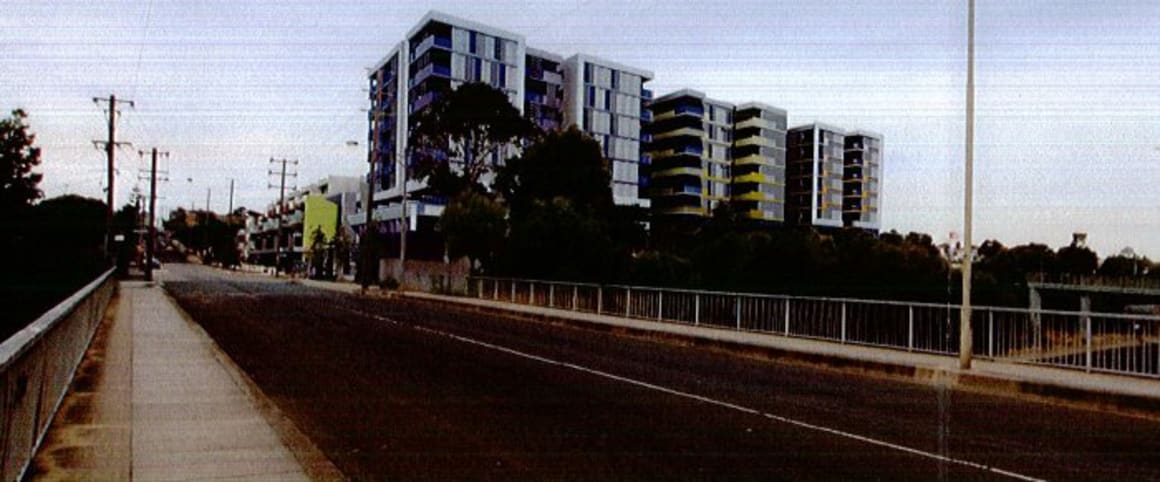A sign of the times > 1-5 Olive York Way, Brunswick West

Testament to the ever changing nature of Melburnian attitudes and propensity for apartment living is a particular site found in Brunswick West abutting Citylink. A former industrial site bound by Albion Street, Duggan Street, Eggington Street and the aforementioned Citylink, the massive tract of land has laid dormant for many years, in the process traversing Melbourne's shift toward higher density living.
After a number of medium density proposals failed to materialise, a fraction of the site was finally developed with 2-6 Olive York Way completed mid 2012. Backed by National Sterling and built by Hickory Group, the three building complex yielded 140 apartments and five retail spaces as outlined in charcoal below.
Following a recent planning application submission to Moreland city Council, a new residential development of a comparable land size to 2-6 Olive York Way is seeking approval, albeit at near three times the density.
With the land address 1-5 Olive York Way and after extensive pre-application discussions with Moreland city Council planners, Equity Properties Pty Ltd have utilised MAP Architecture and Design to deliver the three building complex on a land size of 5297m². Working by the name 'The Complement', the staged development seeks to deliver an impressive 356 apartments.
Heavy with multi coloured precast elements, glass and louvres, the buildings are substantially larger than that of 2-6 Olive York Way and would easily be visible from drivers utilising Citylink. The northernmost building would constitute Stage 1, where 101 apartments are expected with a split of 47 one bedroom and 54 two bedroom apartments. One bedroom options within Stage 1 start at 44.5m², in isolation quite small yet taking into account the age and nature of many low-rise walk-up apartments buildings within Brunswick West (the majority of which are rentals), these are seemingly within reason.
Overall figures see 190 one bedroom options and 153 two bedroom options, 13 split level home offices monopolising the podium space with only the one retail space identified as a cafe. One retail outlet seems light for a complex that may ultimately house 500+ individuals, although the adjoining 2-6 Olive York Way is heavy with retail offerings including an IGA; this apartment complex coming to fruition would no doubt be a boon to those retail operators.
A segregated three level sub ground car park would cover the entire site area with allowances for 418 vehicles, 414 bicycles and 18 motorbikes. Multiple car park entry ramps facing Olive York Way are surrounded by home offices, with dedicated apartments commencing on level three. Attached shadow diagrams show that during a winters day no shadows would be cast over the adjoining complex, only at sunset might shadowing become an issue.
Seen below is the landscape plan where a variety of trees, plants and grasses are utilised where possible. Bottle trees and gums will dominate the larger flora generally located in courtyards between buildings.
And now the crux of today's article, best summarised by the following question. Is a development such as 1-5 Olive York Way more or less important than that of a inner city skyscraper?
Taking into account that a tower say in Melbourne's CBD or Southbank would hold a similar number of apartments (356), yet would be closer to parks, services, a wide spectrum of retail offerings an so on, why do they garner so much media attention? The vast majority of Melburnians don't live within the City of Melbourne yet when a new tower receives media attention, particularly from certain media outlets, the ensuing diatribe goes something like this; it's destroying Melbourne's way of life, it's terrible, it's horrible - we're all going to die!
I would contend that developments such as 1-5 Olive York Way are indeed more important. They may not be as visible as those of the inner city, yet as Melbourne gears up for further population increase, low and mid-rise developments such as 1-5 Olive York Way are paramount in curbing suburban sprawl and increasing urban density in line with the objectives of Plan Melbourne.
If it's lucky 1-5 Olive York Way may attract an article from Moreland Leader and not much more, yet rightly or wrongly apartment developments such as 1-5 Olive York Way are the future and worthy of discussion.